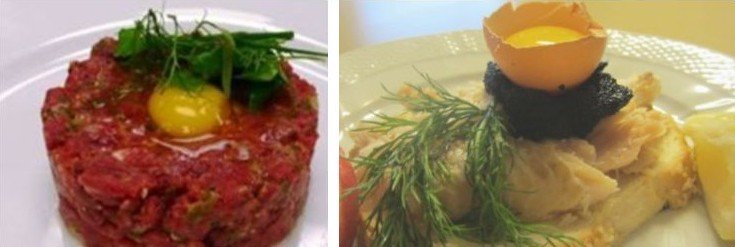Raw eggs
All pictures on this page were borrowed from the internet, except Pic8+9.
a. Raw eggs preparations on the internet
Raw eggs are used in kitchens around the world.
 Pic1: mayonnaise and derived sauces
Pic1: mayonnaise and derived sauces Pic2: : in cereal, porridge; in eggnog a.o. drinks
 Pic3: with raw meat
Pic3: with raw meat
Pic4: with fish
 Pic5: egg whites only: meringue, a.o.
Pic5: egg whites only: meringue, a.o. Pic6: with rice, pasta, mashed potatoes
b. separating raw eggs
Some recipes require that egg yolks be separated from egg whites. There are several methods for doing this. The fresher the eggs, the easier it is to separate them because the egg whites are more liquid. Older eggs lose moisture and the egg whites become thick and cling to the yolk. Trying to pull away the white can be enough to break the yolk, with messy results. (Pic6)
 Pic7: the right way
Pic7: the right wayPic8: which one is busted?
Pic9: one busted yolk will mess up the entire batch
a few methods
There are more than these 3.
 Pic10: using tools
Pic10: using tools
Pic11: 'egg shell swap'
Pic12: hand job
c. pasteurizing raw eggs at home
Quite a few recipes require raw eggs.
Many people are afraid of using raw eggs because of the frequent salmonella scares here in the US of A. Stores sell pasteurized eggs—with a red stamp—but at more than double the cost of regular eggs.
Pasteurized eggs have slightly milkier whites and whipping those whites takes a little bit longer than fresh eggs. No other differences reported.
With the right equipment, you can pasteurize eggs at home. You need a sous-vide cooker or a deep-fryer with an accurate/steady thermostat and a good food thermometer. Use only very fresh eggs.
 Pic13:
pasteurizing eggs
at home
Pic13:
pasteurizing eggs
at home Pic14: left: regular, right: pasteurized
Directions
Preparation:
- Fill the deep fryer to 1” headspace and place the basket in the high position.
That will allow the water to circulate more evenly under the basket. - Set thermostat to 135 ºF and warm up the deep-fryer to 135 ºF.
- IMPORTANT:
- Verify the water temperature with the tip of the food thermometer close to, but not touching the basket.
- Adjust the thermostat until you get the exact 135 ºF temperature for 30 minutes without change.
- If you cannot keep the temperature stable for at least 30 minutes without adjustments, do not do this.
- If your temp goes too low, the eggs won’t be properly pasteurized.
- If too high, they will be boiled hard and unusable for your recipe.
Processing:
- Place the eggs in the water bath.
The water temperature will go down. With a large enough water volume, this might not even be noticeable. - After the temperature has stabilized for 10 minutes at 135 ºF, keep the eggs at 135 ºF for at least 75 minutes. Some recommend 2 hrs.
- Air-dry the eggs on a drying rack.
- When done, mark the eggs with permanent marker to remind you which ones were pasteurized.
- Keep the eggs refrigerated until needed.